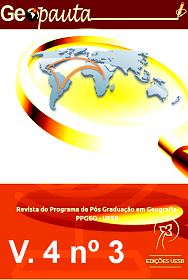Núcleos de terras degradadas do campo calcário Aroeiras e adjacências, municípios de Coreaú e Sobral (Ceará)
DOI:
https://doi.org/10.22481/rg.v4i3.6753Palavras-chave:
Degradação de Terras, Litologia, Extrativismo VegetalResumo
A pesquisa analisa a degradação das terras no campo calcário Aroeiras e adjacências, geossistema apropriado como território da produção de cal e cimento nos municípios de Coreaú e Sobral na região noroeste do Estado do Ceará. Do ponto de vista metodológico, o mapa de uso e cobertura das terras permitiu detectar que os três núcleos de terras degradados identificados estão quase que, exclusivamente, fora do campo Aroeiras, evidenciando uma baixa correlação com a litologia carbonática da formação Frecheirinha e elevada com as formações Coreaú e Trapiá. A degradação nos núcleos está associada ao desmatamento da Caatinga sem controle, enquanto os núcleos conservados correspondem a grandes áreas de plano de manejo florestal e amortecimento aos impactos da mineração de grande porte.
Downloads
Metrics
Referências
AB’SABER, A. N. A problemática da desertificação e da savanização no Brasil. In: Geomorfologia, n° 53. São Paulo: USP. 1977. 20 p.
ALBUQUERQUE, F. N. B. Recurso natural, organização espacial e ordenamento territorial: mineração e degradação de terras na Depressão Interplanáltica Semiárida do Alto Coreaú (CE). Rio Claro: IGCE-UNESP. Tese (Doutorado em Geografia). 2015. 223 f.
ALBUQUERQUE, F. N. B. Organização espacial das caieiras e fornos de cal no campo calcário Aroeiras, municípios de Coreaú e Sobral (CE): passado e presente. Revista Geociências do Nordeste. vol. 5. Nº especial. 2019.
BANCO DO NORDESTE DO BRASIL. A indústria de calcários e dolomitos no Nordeste. Fortaleza: BNB/ETENE. 1987. (Série: Estudos econômicos e sociais, 34).
CENTRO DE GESTÃO E ESTUDOS ESTRATEGICOS – CGEE. Desertificação, degradação da terra e secas no Brasil. Brasília: Centro de Gestão e Estudos Estratégicos, 2016.
CHERLET, M. et al. (eds.). World Atlas of Desertification. 3. Ed. Publication Office of the European Union, Luxembourg. 2018.
CORDANI, U. G.; TAIOLI, F. As ciências da Terra: sustentabilidade e desenvolvimento. In Decifrando a Terra. São Paulo: Companhia Editora Nacional. 2009.
COSTA, J. S. Análise geoambiental da Serra da Penanduba (Coreaú/Frecheirinha): bases geográficas voltadas à criação de unidade de conservação. Sobral/CE: UVA. Dissertação (Mestrado em Geografia). 2015. 105 f.
CREPANI, E. et al. Curso de sensoriamento remoto aplicado ao zoneamento ecológico-econômico. São José dos Campos: INPE, 2001. 25p.
DANTAS, E. W. C. et al. Nordeste brasileiro fragmentado: de uma região com bases naturais a uma fundamentação econômica. In SILVA, J. B. et al. (orgs). Litoral e sertão – natureza e sociedade no nordeste brasileiro. Fortaleza: Expressão Gráfica. 2006. p. 23-44.
DNPM. Mineração no Semiárido Brasileiro. Brasília. 2009.
FAO. Natural resources and the human environment for good and agriculture. Environment Paper. nº 1 Roma. 1980.
FUNCEME. ICID. Áreas degradadas susceptíveis aos processos de desertificação no Estado do Ceará. Brasil. Fortaleza: 1992.
GEOPLAN. Relatório de impacto no meio ambiente (RIMA) do projeto de lavra de calcário (DNPM 805.014/75) Coreaú/CE. Grupo Votorantim. vol. II. jan. 1989.
KOPEZINSKI, I. Mineração x meio ambiente: considerações legais, principais impactos ambientais e seus processos modificadores. Porto Alegre: Ed. da UFRGS. 2000.
MATALLO JÚNIOR, H. Indicadores de desertificação: histórico e perspectivas. Brasília: UNESCO. 2001.
MATALLO JÚNIOR, H. Glossário de termos e conceitos usados no contexto da UNCCD. Brasília: MMA. 2009.
PEREZ-MARIN, A. et al. Núcleos de desertificação no semiárido brasileiro: ocorrência natural ou antrópica? Revista Parcerias Estratégicas. v. 17, n. 34, p. 87-106. Brasília-DF, 2012.
SÁ, I. B. et al. Degradação ambiental e reabilitação natural do trópico semi-árido brasileiro. In: Conferência Nacional e Seminário Latino Americano de Desertificação. Fortaleza, CE. 1994.
SALES, M. C. L. Estudo da degradação ambiental em Gilbués-PI: Reavaliando o “núcleo de desertificação”. São Paulo, USP. Dissertação (Mestrado em Geografia). 1997. 181 f.
SILVA, I. A. S. Clima e arenização em Gilbués-Piauí: dinâmica das precipitações e a vulnerabilidade da paisagem aos eventos pluviais intensos. Goiânia: IESA-UFG. Dissertação (Mestrado em Geografia). 2014. 184 f.
UNCCD. United Nations Convention to Combat Desertification in those Countries Experiencing Serious Drought and/or Desertification, particularly in Africa. 1995.
WESTING, A. Population, Desertification and Migration. Environmental Conservation, 21 (2), 110-114. 1994.
Downloads
Publicado
Como Citar
Edição
Seção
Licença
Copyright (c) 2020 Da Revista Geopauta e do(s) Autor(es)

Este trabalho está licenciado sob uma licença Creative Commons Attribution 4.0 International License.
Dos Direitos Autorais
Os autores mantêm os direitos autorais de forma irrestrita e concedem à Geopauta a primeira publicação com o trabalho simultaneamente licenciado em CC BY.que permite que outros compartilhem com reconhecimento da autoria de cada autor na publicação inicial nesta revista.
Propriedade Intelectual e Termos de uso
Geopauta adota a política de Acesso Livre em Conformidade com o Acesso Aberto- OAC recomendado pelo DOAJ e em conformidade com os Critérios SciELO, sob uma licença Creative Commons CC By Attribution 4.0 International License, permitindo acesso gratuito imediato ao trabalho e permitindo que qualquer usuário leia, baixe, copie, distribua, imprima, pesquise ou vincule aos textos completos dos artigos, rastreie-os para indexação, passe-os como dados para software ou use-os para qualquer outra finalidade legal.
Geopauta atribui a licença CC BY. onde é permitido sem restrições:
Compartilhar — copiar e redistribuir o material em qualquer suporte ou formato para qualquer fim, mesmo que comercial. desde que lhe atribuam o devido crédito pela criação original.
Adaptar — remixar, transformar, e criar a partir do material para qualquer fim, mesmo que comercial desde que lhe atribuam o devido crédito pela criação original.











